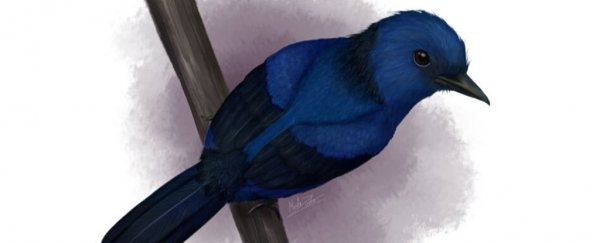For the first time, scientists have found a blue-feathered bird in the fossil record, thanks to a new discovery that lets us tell which fossilised pigments are, in fact, blue.
After millions of years of fossilisation, feathers are long gone, but melanin pigment packages called melanosomes can be preserved – up until now the problem has been telling blacks, browns, greys and blues apart, but experts have now been able to spot the difference.
It could lead to a whole new appreciation of what prehistoric birds looked like, including the Eocoracias brachyptera species that was the subject of this particular research.
"We have discovered that melanosomes in blue feathers have a distinct range in size from most of colour categories and we can, therefore, constrain which fossils may have been blue originally," says palaeontologist Frane Babarović from the University of Sheffield in the UK.
 Eocoracias brachyptera fossil sample. (Sven Traenkner/Senckenberg Research Institute and Nature Museum)
Eocoracias brachyptera fossil sample. (Sven Traenkner/Senckenberg Research Institute and Nature Museum)
Key to the discovery was being able to compare the E. brachyptera fossils with their modern-day equivalents, the roller birds. That analysis helped the researchers figure out whether they were looking at fossils from blue or grey birds – both of which leave behind melanosomes much longer (1,400 nanometres) than they are wide (300 nanometres).
To add to the complexity, certain feather colours – including blue and green – don't just come about through melanin alone, but become visible thanks to additional cell structures and light refraction. These are known as structural colours and can often be iridescent, too (think of the tail feathers of a peacock, for example).
By assessing the predominance of blue and grey in the family trees of living birds, and studying the melanosomes in the E. brachyptera fossils, the researchers concluded that there was a 99 percent chance the prehistoric bird had a non-iridescent structural colour, and only a 19 percent chance its feathers were grey.
"The overlap with grey colour may suggest some common mechanism in how melanosomes are involved in making grey colouration and how these structural blue colours are formed," says Babarović.
"Based on these results in our publication we have also hypothesised potential evolutionary transition between blue and grey colour."
These interesting findings could become yet another resource for researchers to use when studying fossils in the future.
The team suggests that future studies might also focus on the differences and similarities between grey and blue colouring in feather development, with grey thought to be much more common. E. brachyptera is a colourful, 48-million-year-old exception.
"We also need to understand how grey colour is made," says Babarović. "This is made in a very different way in birds than it is in mammals."
"We believe it is related to how the melanosome shape can result in a kind of self-assembling process in the feather and the surface tension of the melanosomes pull them into certain configurations inside a feather as it forms."
The research has been published in the Journal of the Royal Society Interface.
